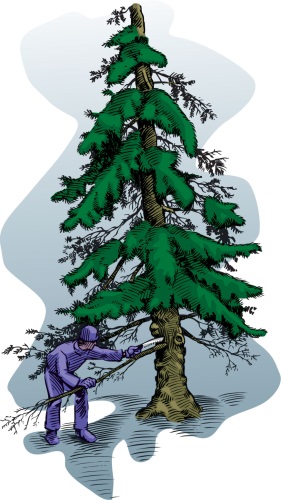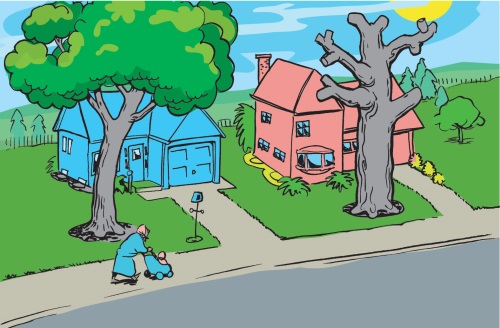Pruning Trees
 Pruning is the most common tree maintenance procedure. Unlike forest trees, landscape trees need a higher level of care to maintain structural integrity and aesthetics. Pruning must be done with an understanding of tree biology because improper pruning can create lasting damage or shorten the tree’s life.
Pruning is the most common tree maintenance procedure. Unlike forest trees, landscape trees need a higher level of care to maintain structural integrity and aesthetics. Pruning must be done with an understanding of tree biology because improper pruning can create lasting damage or shorten the tree’s life.
Learn more about mature tree pruning.
Reasons for Pruning
 Each cut can potentially change the growth of the tree; therefore, it is important to remember that no branch should be cut without a reason. Some common reasons for pruning include, removal of dead branches to improve form and increase safety, to increase light and air penetration for plants below the tree’s crown, or corrective and preventative measures.
Each cut can potentially change the growth of the tree; therefore, it is important to remember that no branch should be cut without a reason. Some common reasons for pruning include, removal of dead branches to improve form and increase safety, to increase light and air penetration for plants below the tree’s crown, or corrective and preventative measures.
When to Prune
Most light, routine pruning to remove weak, dead, or diseased limbs can be accomplished at any time during the year with little effect on the tree.
As a rule, growth and wound closure are maximized if pruning takes place before the spring growth flush. Heavy pruning of live tissue just after the spring growth flush should be avoided, especially on weak trees.
Tree diseases, such as oak wilt, can be spread when pruning wounds provide access to disease-causing agents. Susceptible trees should not be pruned during active transmission periods.
If you’re unsure about when to prune, contact your local arborist.
Pruning Techniques
Specific types of pruning may be necessary to maintain a mature tree in a healthy, safe, and attractive condition.
- Cleaning is the removal of dead, dying, diseased, weakly attached, and low-vigor branches from the crown of a tree.
- Raising removes the lower branches from a tree to provide clearance for buildings, vehicles, pedestrians, and vistas.
- Reduction reduces the size of a tree, often for utility line clearance. Reducing a tree’s height or spread is best accomplished by pruning back the leaders and branch terminals to secondary branches that are large enough to assume the terminal roles (at least one-third the diameter of the cut stem). Compared to topping, reduction helps maintain the tree’s form and structural integrity.
- Reducing density of foliage at the crown periphery, thinning, is sometimes performed to increase wind or light penetration for aesthetic reasons and to promote interior foliage development.
Pruning Young Trees
Structural pruning is essential in developing a tree with a strong structure and desirable form. Trees that receive the appropriate pruning while young will require less corrective pruning as they mature.
Remember that each cut has the potential to change the growth of the tree, therefore it is important to set an objective for why the tree will be pruned. For young trees the objective is to improve tree structure. Poor pruning can cause damage the tree must grow over causing the wound to stay within the tree forever.
Learn more about pruning young trees.
Pruning Palms
Most pruning of palms is done to remove dead or dying fronds, inflorescences (flowering), and/or fruiting clusters, particularly those that may be a potential risk to the public, such as coconuts.
Pruning is usually conducted at least biannually. Coconuts may be pruned as often as every 3–4 months to minimize the risk of injury or damage from the heavy fruit. Great care should be taken to avoid any damage to the terminal bud. Over-pruned palms may have slower growth and may attract pests.
Generally, remove old, dead, lower fronds only, unless otherwise required for clearance. Occasionally, live green fronds, where the frond shaft has descended below a horizontal plane, can be removed. Removing live fronds where the shaft is greater than 45 degrees above horizontal is not known to reduce future pruning requirements.
Climbing spikes should not be used to climb palms for pruning because they permanently wound the palm trunk. Wounds on palms do not close.
Learn more about palms.
Don’t Top Trees!

Topping is the indiscriminate cutting of tree branches to stubs or to lateral branches that are not large enough to assume the terminal role. Topping is often used to reduce the size of a tree, but it is perhaps the most harmful tree pruning practice known.
Topping can lead to unacceptable risk, tree stress, and decay. It is also expensive and destroys the natural form of the tree.
Alternatives to topping include removing small branches to their point of origin, or pruning back larger limbs to a lateral branch that is large enough to assume the terminal role. Sometimes the best solution is removing the tree and replacing it with a species that is more appropriate for the site.
Be sure to consult with a local arborist about alternatives to topping.
Learn more about why topping hurts trees.